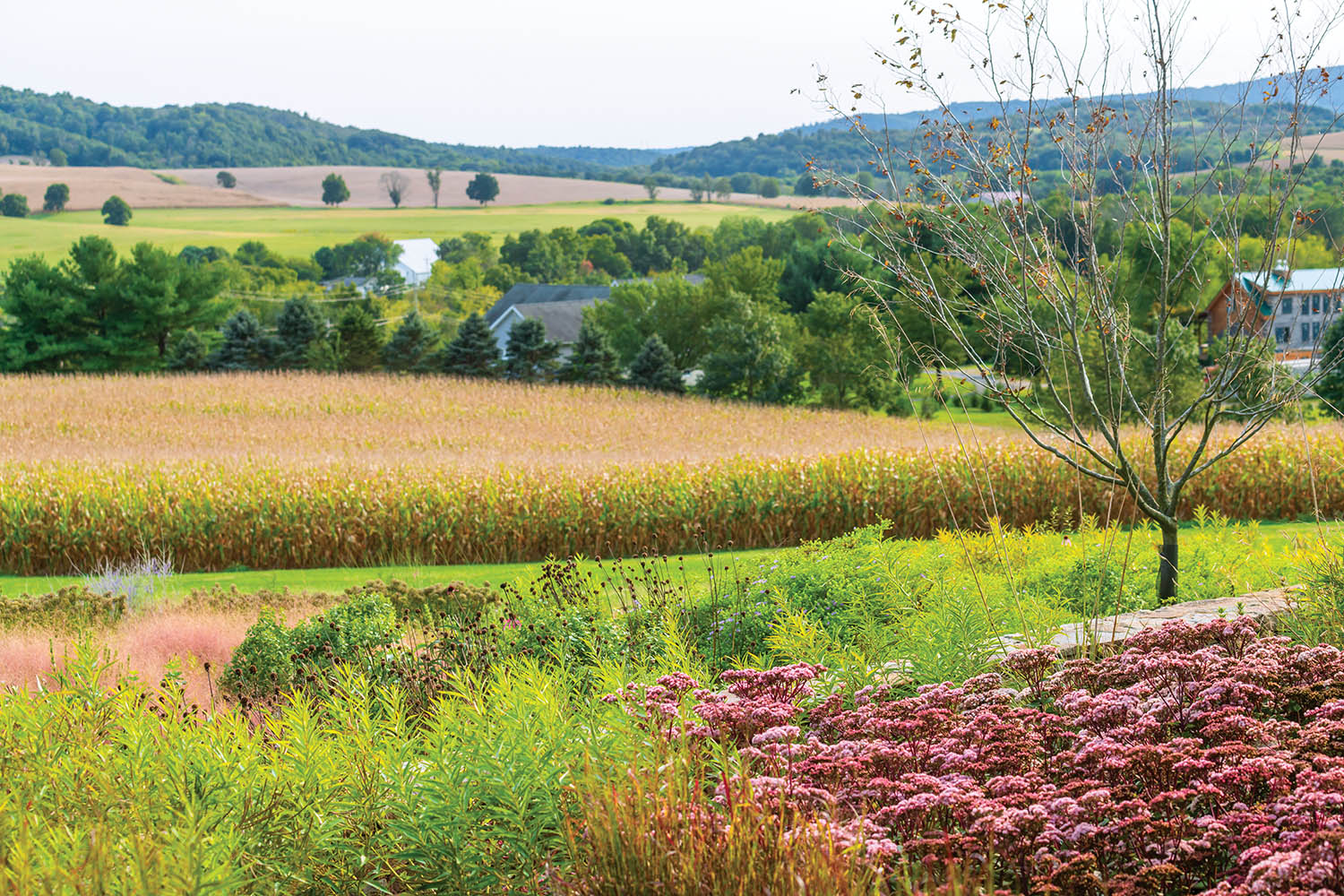
Photo by Rob Cardillo

Photo by Rob Cardillo
Landscape designer Don Pell wades in a planting of ‘Standing Ovation’ little bluestem and Calamagrostis x acutiflora ‘Karl Foerster’ at his studio/test garden. By trialing the plants, he learns personality traits to help mingle them effectively for clients.
Once on board, Don began putting pen to paper to realize the Powers’ vision. The couple, having replaced the former house with a window-rich home surrounded by a wraparound porch, desired a landscape that would complement both the house and the mountains. “Our one wish was to create a broad, sweeping, Impressionistic scene that would read from the road below while also spreading like a blanket to skirt the house and frame the view,” says Bob. And that’s exactly the sort of design that Don does so well.
Given the blank slate to be creative with composition, Don saw an opportunity to interweave a symphony in various textures and mixtures. Every square foot of the garden is a dialogue featuring harmonies between plants performing their various moments of splendor, from emerging foliage to flower to seedhead and dried blades. It looks natural and fits comfortably into the scene. In fact, from a distance driving by, some of the townsfolk are not sure there is a garden at the top of the hill. But in truth, the entire scene has been meticulously orchestrated.

Photo by Rob Cardillo
Eryngium yuccifolium blushes red in autumn to heighten its beauty.

Photo by Rob Cardillo
Don creates combinations like Panicum virgatum ‘Shenandoah’ and Pycnanthemum muticum based on their year-round performance, as well as his vast knowledge of the plants.
While ornamental grasses form the backbone of the plantings, they also serve the very necessary function of anchoring the site with deep roots tenaciously clinging to soil that could easily erode. As a result, they shoulder the gusts rushing up the hill. Even on a calm day, the garden is rustling. “The grasses also help shade the tender, cool-season plants,” Don says. “It all functions as a plant community—sort of an ecosystem.”

Photo by Rob Cardillo
When creating plantings abutting the Powers’ wraparound porch, Don harmonized stem colors, leaf textures, and growth habits, as well as flower hues. Additionally, he factors winter performance into the formula.
The garden reaches full volume in autumn, but the beauty of the scene is that it remains dynamic throughout the year. Cutback is held until late winter/ early spring, letting the bulbs emerge. In spring, bulbs kick off the growing season. Some self-seeding is permitted, although when certain perennials begin to overdominate, their seedheads are removed before they can scatter. That was the case for the Eryngium yuccifolium and Echinops. Amsonia also proved a little too generous with its will to increase. “Getting the succession right is part of the challenge, but that’s what an ecological planting is all about,” says Don. Having experimented with various cultivars, he suspected that ‘Standing Ovation’ little bluestem would perform best in the shale soil. Other plants that appreciate the gritty location, such as Russian sage (Salvia yangii, formerly Perovskia), also thrive particularly well.

Photo by Rob Cardillo
To frame the neighboring cornfield, Don created a block of Sedum ‘Matrona’ abutting Amsonia tabernaemontana var. salicifolia. Carpinus caroliniana (American hornbeam) is among the few trees able to tolerate the windswept hill.
Although the composition is deftly orchestrated, Don does not do complex layouts on paper. “I function differently compared to other garden designers,” he says. “I work with palettes.” His gardens are roughly drawn out on paper to plan the number of plants needed and to communicate the hardscape with contractors. Then Don personally lays out the design to achieve the symbiosis he desires. Even now with a national presence, Don still installs each site. “That’s when I have the most fun,” he says. “And we’re all at our best when we’re having fun.”
The Powers mention another perk of the garden that they didn’t predict—the music created as the winds wave through the plants and the blades sway in the breezes. “It’s almost like an ocean,” says Susan. She has also discovered a fondness for the crunch of gravel as she follows the pathways skirting the house. And then there’s the wildlife and its contribution to the dialogue. Beyond the hum of insects, there is the whoosh of goldfinches and other birds that adds to the harmony. It truly is a powerful composition.




